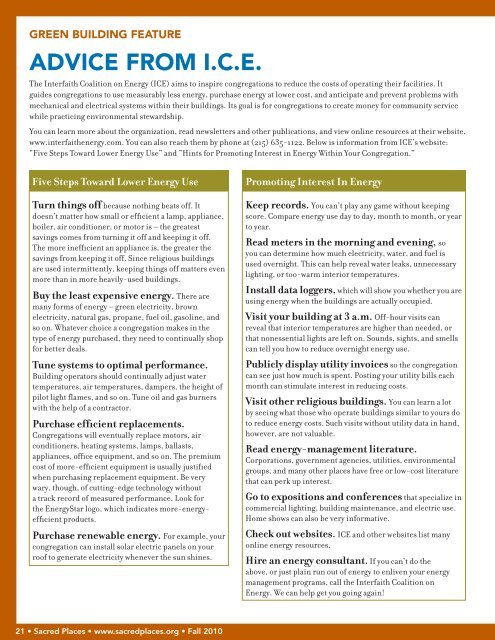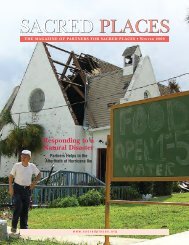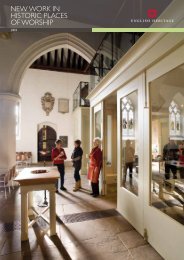FEATURE STORY - Partners for Sacred Places
FEATURE STORY - Partners for Sacred Places
FEATURE STORY - Partners for Sacred Places
Create successful ePaper yourself
Turn your PDF publications into a flip-book with our unique Google optimized e-Paper software.
GREEN BUILDING <strong>FEATURE</strong><br />
ADVICE FROM I.C.E.<br />
The Interfaith Coalition on Energy (ICE) aims to inspire congregations to reduce the costs of operating their facilities. It<br />
guides congregations to use measurably less energy, purchase energy at lower cost, and anticipate and prevent problems with<br />
mechanical and electrical systems within their buildings. Its goal is <strong>for</strong> congregations to create money <strong>for</strong> community service<br />
while practicing environmental stewardship.<br />
You can learn more about the organization, read newsletters and other publications, and view online resources at their website,<br />
www.interfaithenergy.com. You can also reach them by phone at (215) 635-1122. Below is in<strong>for</strong>mation from ICE’s website:<br />
“Five Steps Toward Lower Energy Use” and “Hints <strong>for</strong> Promoting Interest in Energy Within Your Congregation.”<br />
Five Steps Toward Lower Energy Use<br />
Turn things off because nothing beats off. It<br />
doesn’t matter how small or efficient a lamp, appliance,<br />
boiler, air conditioner, or motor is – the greatest<br />
savings comes from turning it off and keeping it off.<br />
The more inefficient an appliance is, the greater the<br />
savings from keeping it off. Since religious buildings<br />
are used intermittently, keeping things off matters even<br />
more than in more heavily-used buildings.<br />
Buy the least expensive energy. There are<br />
many <strong>for</strong>ms of energy – green electricity, brown<br />
electricity, natural gas, propane, fuel oil, gasoline, and<br />
so on. Whatever choice a congregation makes in the<br />
type of energy purchased, they need to continually shop<br />
<strong>for</strong> better deals.<br />
Tune systems to optimal per<strong>for</strong>mance.<br />
Building operators should continually adjust water<br />
temperatures, air temperatures, dampers, the height of<br />
pilot light flames, and so on. Tune oil and gas burners<br />
with the help of a contractor.<br />
Purchase efficient replacements.<br />
Congregations will eventually replace motors, air<br />
conditioners, heating systems, lamps, ballasts,<br />
appliances, office equipment, and so on. The premium<br />
cost of more-efficient equipment is usually justified<br />
when purchasing replacement equipment. Be very<br />
wary, though, of cutting-edge technology without<br />
a track record of measured per<strong>for</strong>mance. Look <strong>for</strong><br />
the EnergyStar logo, which indicates more-energyefficient<br />
products.<br />
Purchase renewable energy. For example, your<br />
congregation can install solar electric panels on your<br />
roof to generate electricity whenever the sun shines.<br />
Promoting Interest In Energy<br />
Keep records. You can’t play any game without keeping<br />
score. Compare energy use day to day, month to month, or year<br />
to year.<br />
Read meters in the morning and evening, so<br />
you can determine how much electricity, water, and fuel is<br />
used overnight. This can help reveal water leaks, unnecessary<br />
lighting, or too-warm interior temperatures.<br />
Install data loggers, which will show you whether you are<br />
using energy when the buildings are actually occupied.<br />
Visit your building at 3 a.m. Off-hour visits can<br />
reveal that interior temperatures are higher than needed, or<br />
that nonessential lights are left on. Sounds, sights, and smells<br />
can tell you how to reduce overnight energy use.<br />
Publicly display utility invoices so the congregation<br />
can see just how much is spent. Posting your utility bills each<br />
month can stimulate interest in reducing costs.<br />
Visit other religious buildings. You can learn a lot<br />
by seeing what those who operate buildings similar to yours do<br />
to reduce energy costs. Such visits without utility data in hand,<br />
however, are not valuable.<br />
Read energy-management literature.<br />
Corporations, government agencies, utilities, environmental<br />
groups, and many other places have free or low-cost literature<br />
that can perk up interest.<br />
Go to expositions and conferences that specialize in<br />
commercial lighting, building maintenance, and electric use.<br />
Home shows can also be very in<strong>for</strong>mative.<br />
Check out websites. ICE and other websites list many<br />
online energy resources.<br />
Hire an energy consultant. If you can’t do the<br />
above, or just plain run out of energy to enliven your energy<br />
management programs, call the Interfaith Coalition on<br />
Energy. We can help get you going again!<br />
21 • <strong>Sacred</strong> <strong>Places</strong> • www.sacredplaces.org • Fall 2010
















